Chapter 1, Part 8
In the late eighth century AD, the construction of what would become the world’s biggest Buddhist shrine began during King Dharanindra’s reign. Despite its colossal size, historical accounts of its decades-long construction are scarce, allowing multiple theories to emerge and feeding people’s imaginations.
Taking the layout of a giant mandala – how the universe is perceived in Buddhism cosmology – Bhumisambara, Borobudur’s original name, was built as a stepped pyramid. At the base of the massive temple, reliefs of Karmawibhangga – depiction of human life in the endless cycle of death and rebirth (samsara) as well as the law of cause and effect (karmic law) – were carved on all sides over andesite stones of volcanic origin. Above the base, multiple layers of structures were added, symbolizing Kamadhatu (the world of desires) at the low levels, Rupadhatu (the world of forms) at the mid-levels, and Arupadhatu (the formless world) at the upper levels, a long path one must take to attain enlightenment.
The Karmawibhangga section, however, was covered by stone encasement by later rulers whose intention remains a mystery. Today only the reliefs at the southeast corner of the encasement is left exposed for visitors to see and imagine how the temple looked like right after its completion.
Reliefs of Lalitavistara (the story of Siddharta Gautama from the time he was born until he reached enlightenment), Jataka and Avadana (stories of the teachings of the Buddha), and Gandavyuha (the story of a young man named Sudhana who sought for enlightenment) along with the hidden Karmawibhangga reliefs were carved on a staggering 1,460 panels adorning all sides and levels of the monument except Arupadhatu.
Arupadhatu itself, probably the most iconic part of Borobudur, took shape of a circle, representing the formless world in Mahayana Buddhist tradition. A multitude of Buddha statues, all but one are concealed within small stupas, encircle the biggest stupa at the top center of the shrine. In total, from Kamadhatu to Arupadhatu, there were 504 Buddha statues. Most of them remain on their places, albeit many are headless and more than three dozens are still missing. Museums and private art collectors are the usual culprits, although the looting of the Egyptian Museum during the 2011 uprising may help their argument in keeping artifacts from around the world safe, regardless the controversies.
Despite its location at the heart of Java, reliefs of ancient ships were carved on some panels of Borobudur, suggestive of Medang-Srivijayan maritime tradition as well as hegemony in the region. However regarding the location, an early 20th century Dutch explorer named Wijnand Otto Jan Nieuwenkamp, whose image was immortalized on a temple by the locals in northern Bali, described the Javanese temple in an intriguing way: Borobudur looked like a lotus floating in the middle of a lake.
There was, of course, no lake around the shrine by the time of his visit. Nevertheless today many villages and places around Borobudur bear water-related names, and geologists found alluvial deposit – a typical soil found near inland body of water – around the temple. No conclusive results have been announced so far, leaving only our imagination to render the Buddhist temple’s past a hypothetical, majestic setting.
Today Borobudur still is the largest single Buddhist monument in the world in spite of centuries of destruction caused both by human and nature, notably volcanic eruptions and earthquakes. It was the crown jewel of the Sailendras, although not long after its completion during the reign of Samaratungga Mahayana Buddhism’s grip on Medang’s royal court was seriously challenged by the resurgence of Hinduism, a former power sidelined for centuries and ready to make a comeback to the Javanese royal court.
Click here for the full list of stories from the Spice Odyssey series.
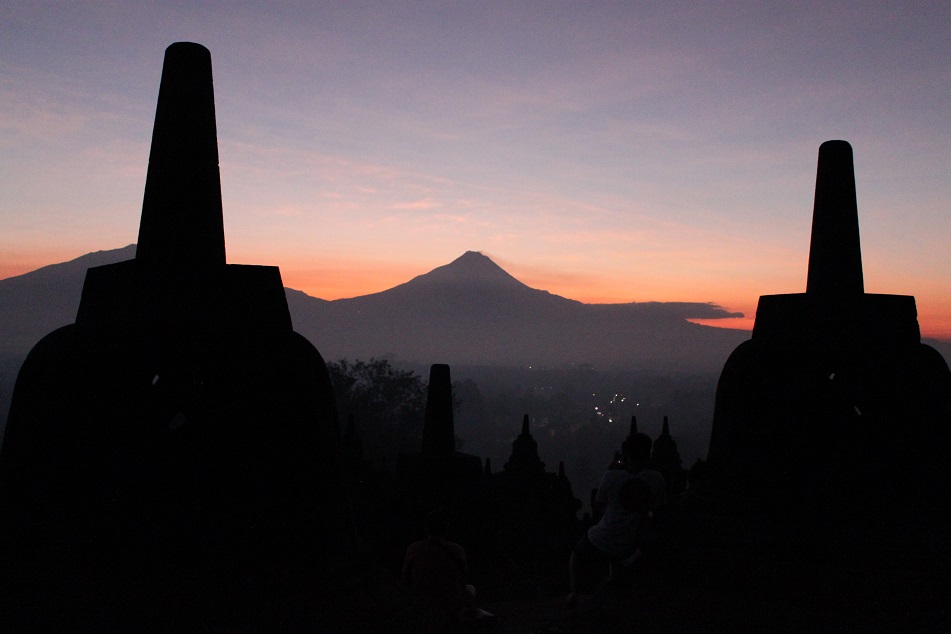
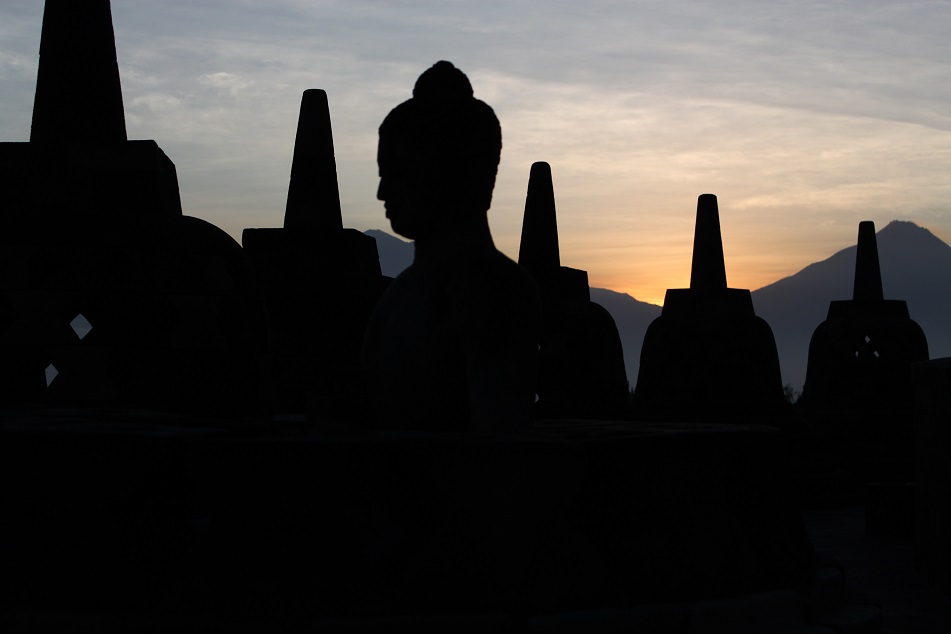
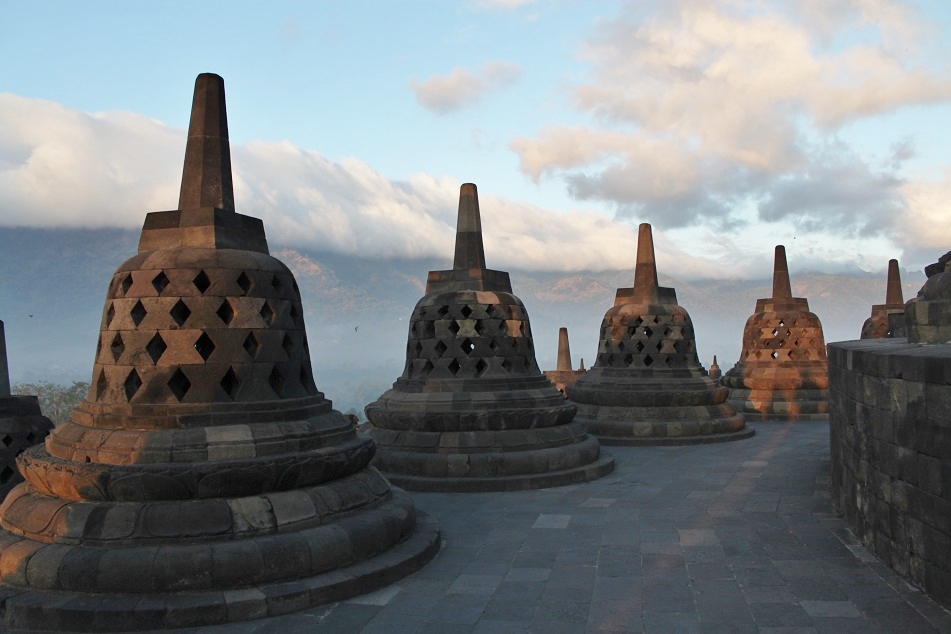
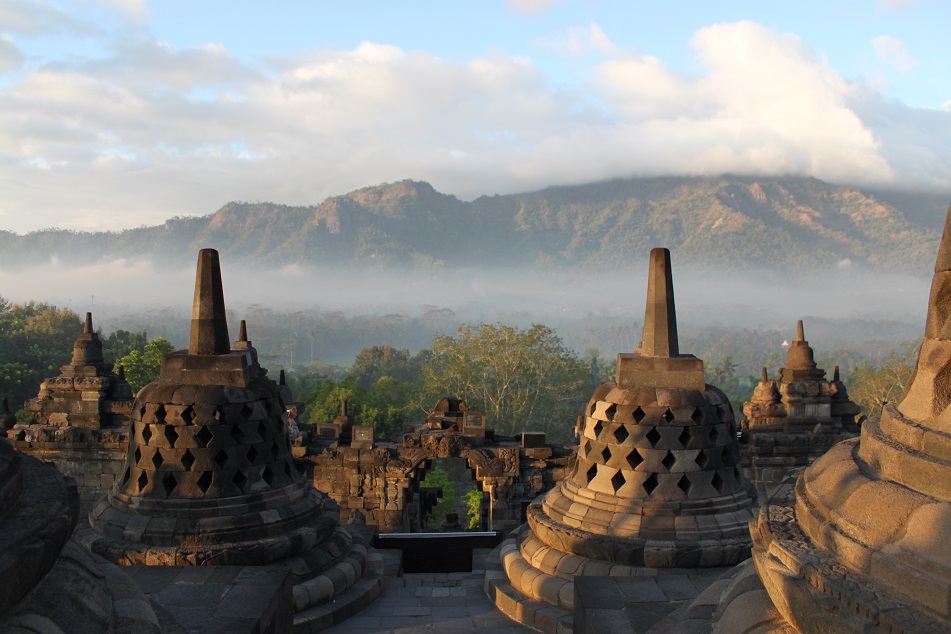


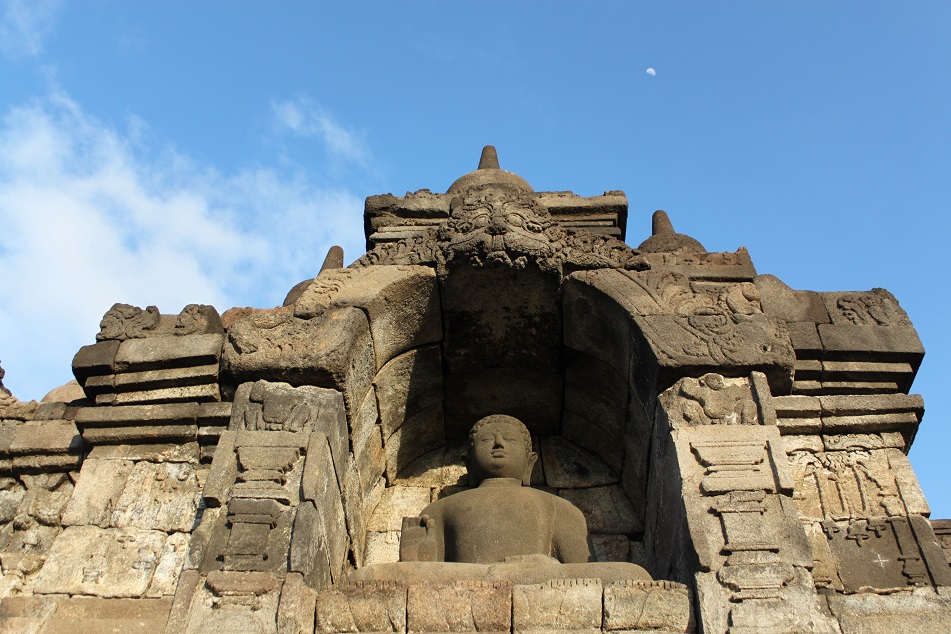
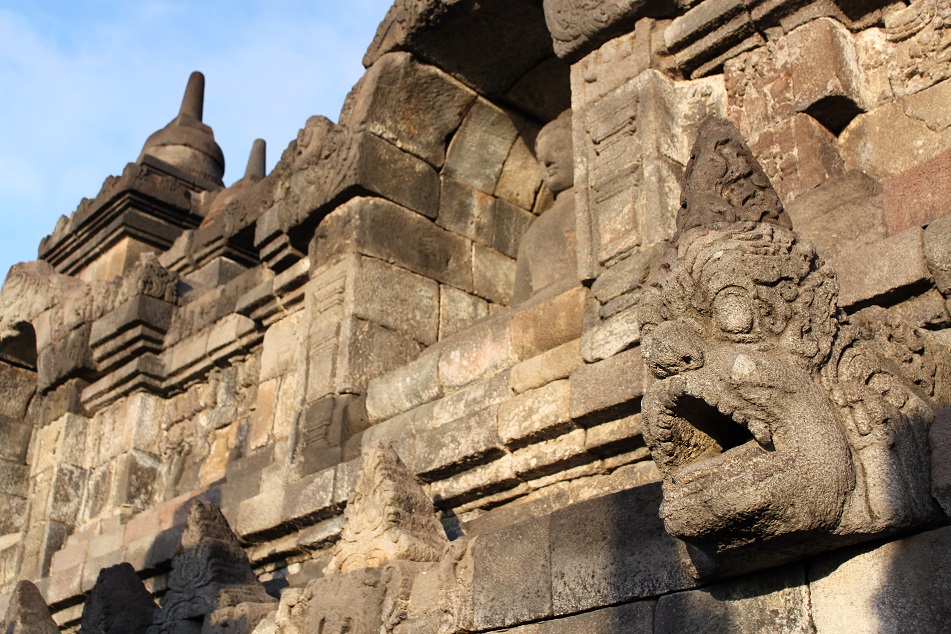
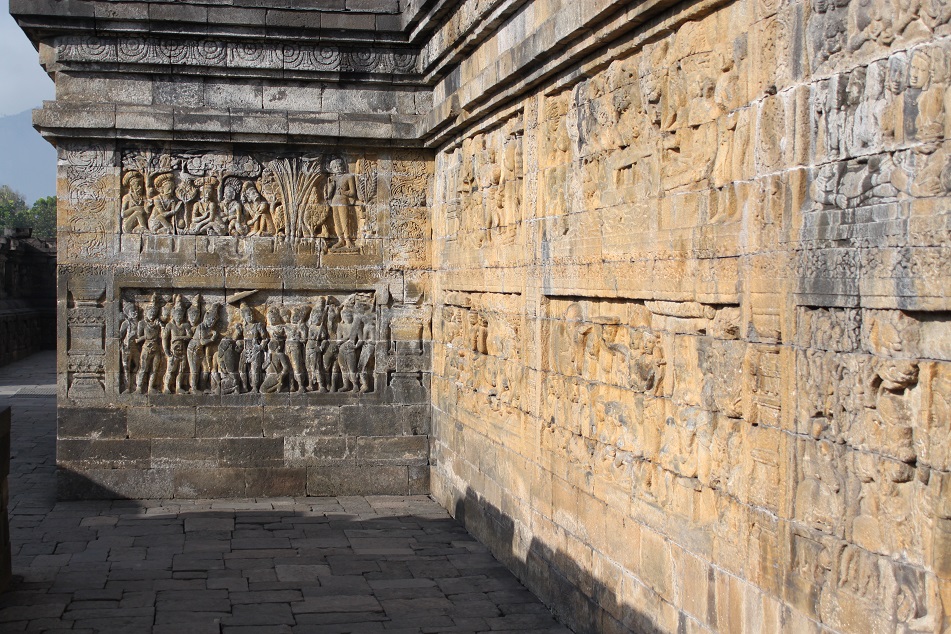
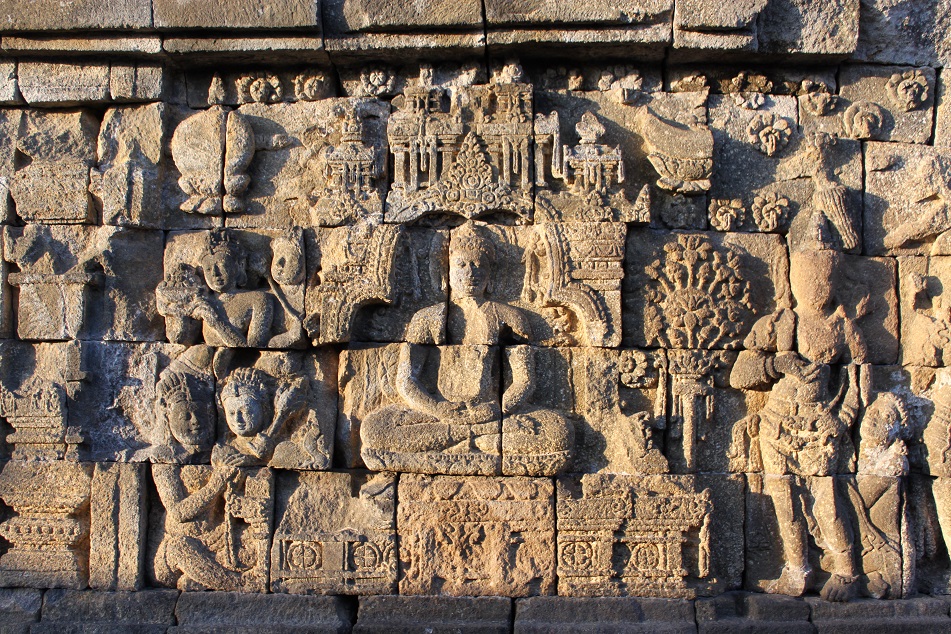
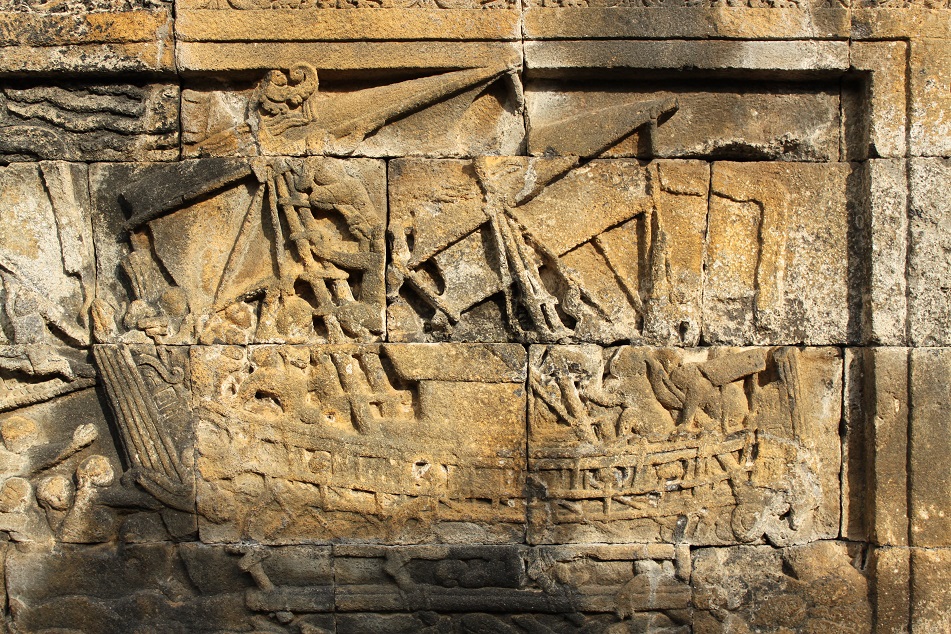
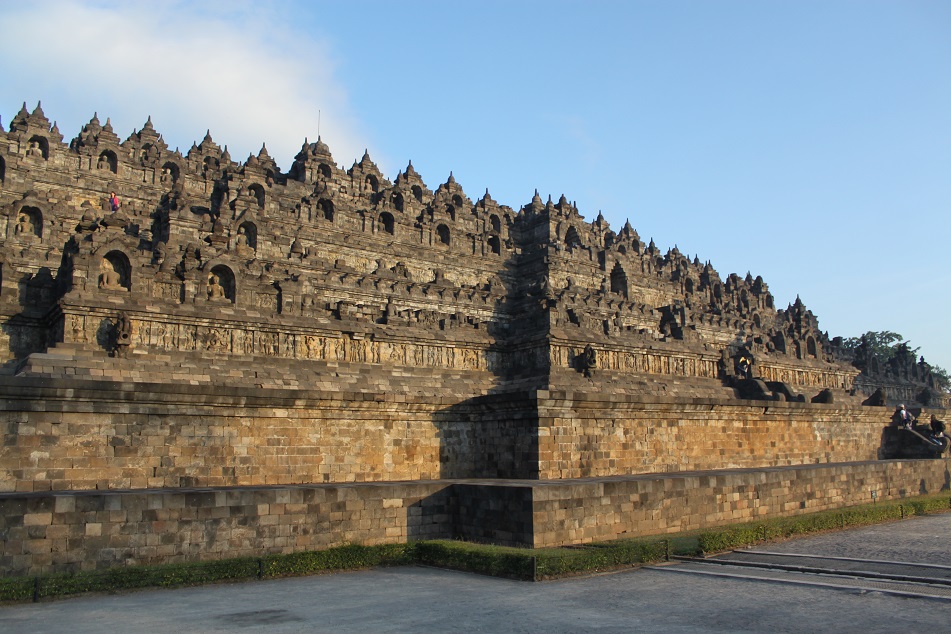
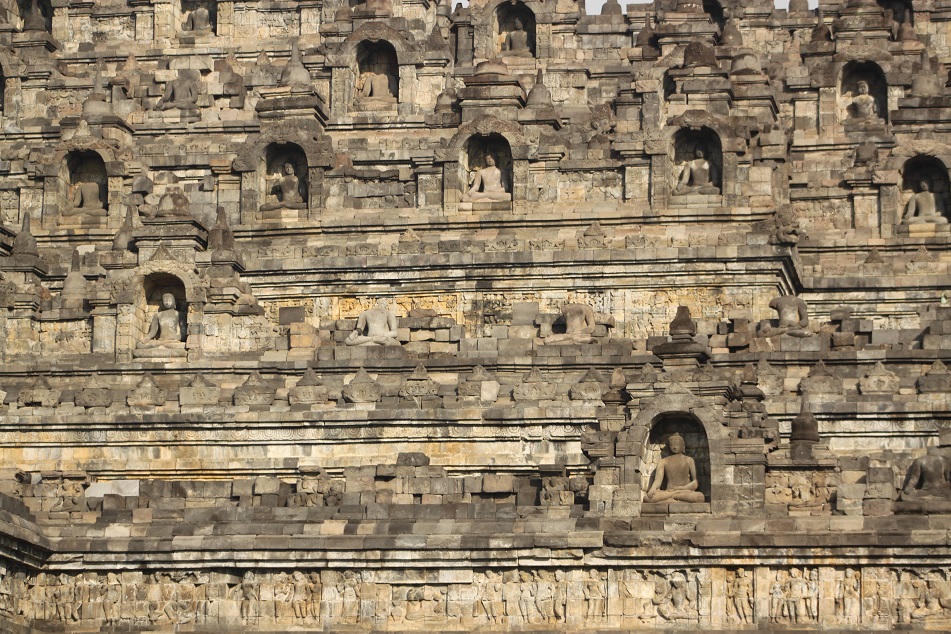
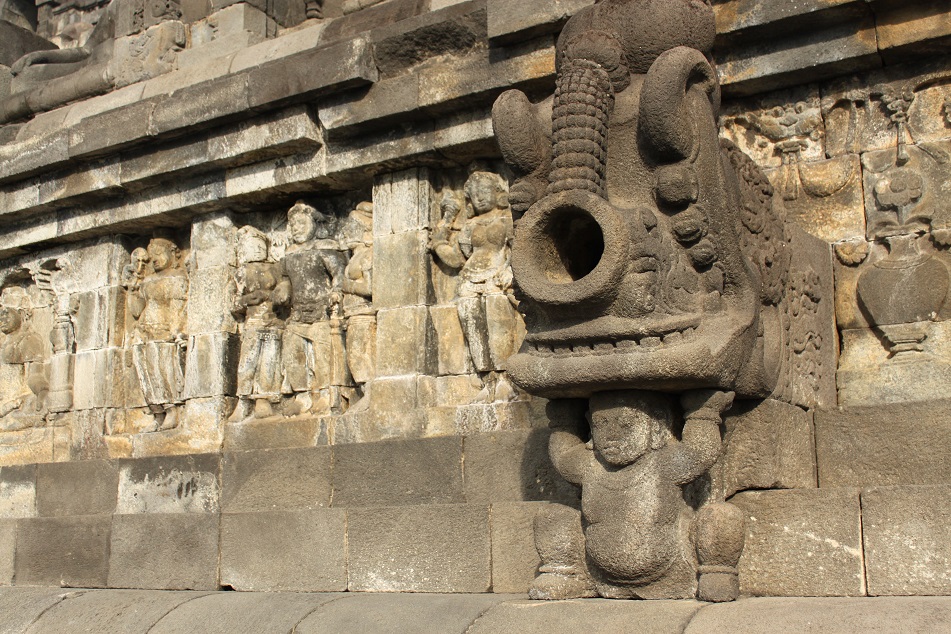
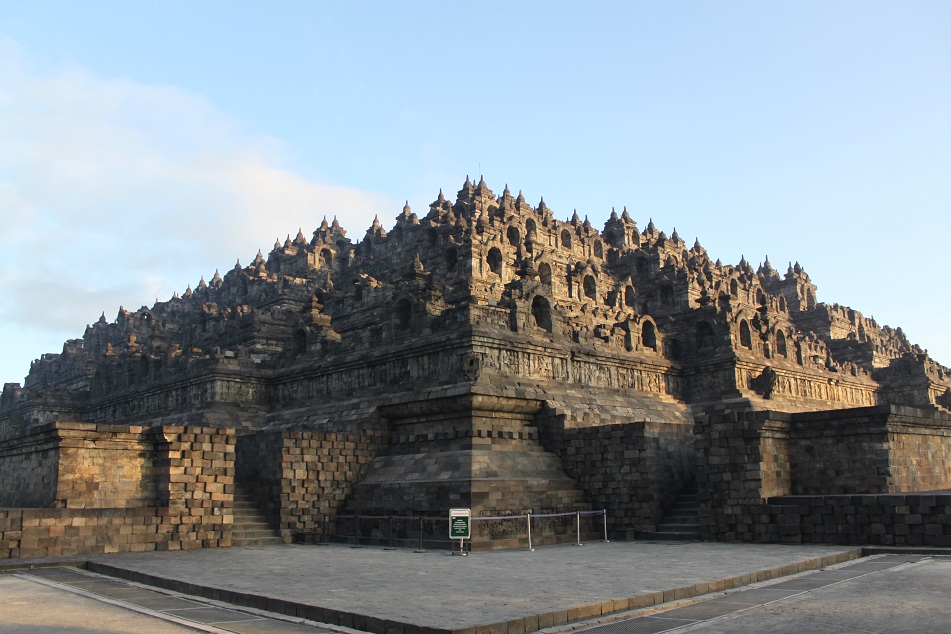
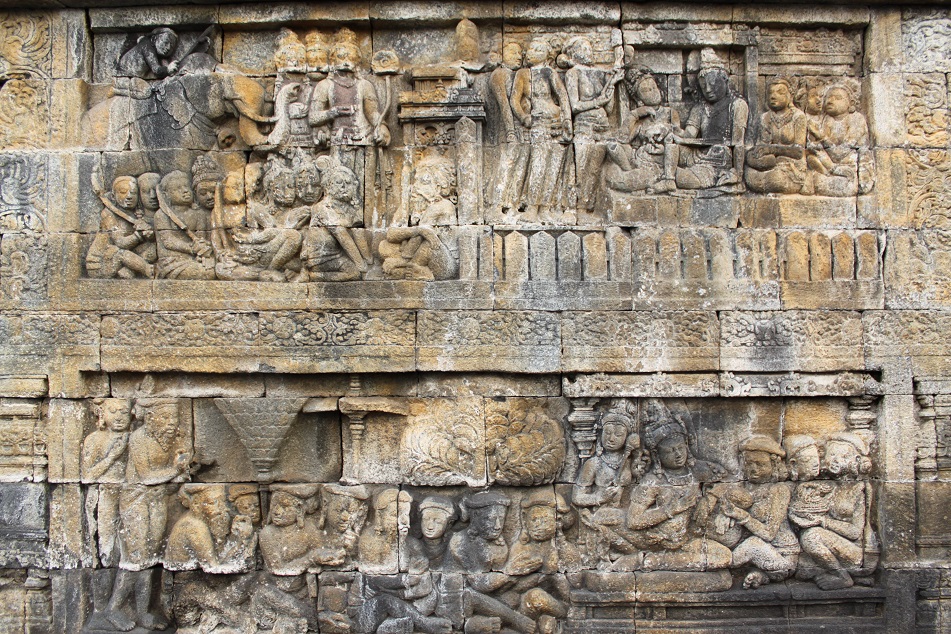
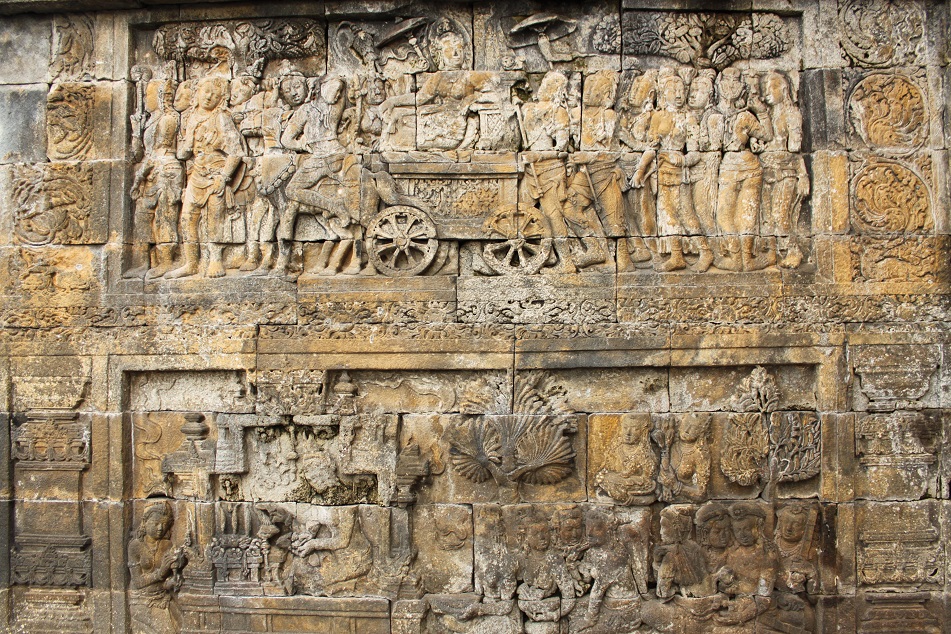

Love your photos. I took my daughter when she was too you to appreciate this amazing site and all she wanted to do was get to the markets below.
LikeLike
Thank you, Mallee. All kids are the same — I went to Borobudur the first time when I was probably seven years old. I was not interested in history nor ancient art back then. I guess that means your daughter needs to go back. 🙂
LikeLike
As usual, I love your story and photos about Borobudur. An amazing storyteller, Bama 🙂
A floating lotus? Wow never heard about this hahaha.. but brilliant!
Btw, saya merasakan kegembiraan dan kepuasan Bama bisa mengambil foto2 Borobudur sejak matahari terbit itu lho. Foto2nya bicara hehe…
LikeLike
Makasih Mbak. The lake theory really piqued my interest when I first read about it a few years ago. Wouldn’t it be truly magnificent if in the past Borobudur was indeed like a giant lotus in the middle of a lake?
Wah, makasih lho mbak. Barusan foto-fotonya bisik-bisik ke saya, nitip dibilangin makasih juga (fotonya bicara ceritanya). 🙂
LikeLiked by 2 people
Pernah kesini waktu kelas 4 SD… udah lama banget. Tapi rasanya masih ingat pengalaman waktu kesana. Lihat foto-fotomu yang detail bikin pengen kesana lagi bam. Pengen ambil gambar dari angle yang sama .
LikeLike
Karena saya sekolah di pulau Jawa jadi ya biasanya kalau study tour ke Jogja lagi Jogja lagi. 🙂 Tapi buat pecinta sejarah dan arsitektur kuno Borobudur ini memang gak akan pernah ngebosenin. Ayo datang lagi, ambil foto yang banyak, dan mudah-mudahan pas cuacanya sedang bagus.
LikeLiked by 1 person
The opening photograph of your post is perfect…like slipping into a past long forgotten (or in my case, not aware of in the first place). The history tying in how the universe as perceived in Buddhism (the mandala) with Borobudur is a tie in that get the mind wondering and imagination flowing ~ and your photos do the rest.
LikeLike
Thank you so much, Randall. Being at Borobudur early in the morning did spark my imagination, although catching the sunrise there is getting more and more popular nowadays. However its immensity was really humbling, and walking along those corridors and following the stories on the relief panels made me think how far of an artistic endeavor those ancient people had achieved.
LikeLike
Incredible pictures. This is a place i am not familiar with but your photos and text brought it to life.
LikeLike
Thanks Marie. Borobudur was first rediscovered in the early 19th century when the British ruled Java for a brief period of time. Its popularity among European scholars in the past is palpable in some places — I went to the Natural History Museum in Vienna and was surprised to see an old painting of Borobudur in one of the galleries.
LikeLike
Some great shots and yes I can tell you were up early : )) Brings back memories of some days spent there in the early 90’s. I likenthe thought of it as a lotus floating on a pond …. it is truly one of the wonders of the world!
LikeLike
Thanks Trees. My friends and I woke up at 4 and I think by 5 we were already at the temple. But it was really worth it. I first came to Borobudur in the early 90s, so maybe we were there at the same time. 🙂 I haven’t been to even half of the globe, but I believe Borobudur really is one of the wonders of the world.
LikeLiked by 1 person
Borobudur was just incredible. Going back there last July, after a space of at least 17 years, was like experiencing it for the first time. Your photos are gorgeous! My favourite shot is the relief of the Borobudur Ship – it really comes alive with all its details in the soft morning light. I guess most records of the temple’s construction were lost because they were written on lontar palm leaves.
LikeLike
I know what you mean — I went to Borobudur for the third time when I was in high school but it felt as if it was my first visit. I was as amazed as my friends who were there for the first time. Makasih James! Actually only on my last visit with you I realized that there were more than one panel depicting the ship. Yea, I wish they recorded the historical accounts on stone slabs so at least later generations wouldn’t lose much of the information about their ancestors.
LikeLiked by 1 person
Wow, stunning photos, it’s amazing how you capture the magic! Makes me want to pack my bags this minute.
LikeLike
Thank you, Katha. Magical is the right word to describe what I witnessed that morning. When you’re in Java one day, make sure not to miss Borobudur and the other ancient temples around Jogja (Yogyakarta).
LikeLike
Borobudur is hands down the best single ‘attraction’ I have ever visited. Better than Angkor Wat, better than Machu Picchu, better than Chichen Itza, better than the Pyramids, better than the Taj Mahal, better than temples of Bagan… I have been twice to Borobudur (not enough times!) but I always love to look at other people’s photos…I can learn something new every day. Your shots are incredible Bama! 🙂
LikeLike
Lee, of all the places you mentioned I have only been to Angkor Wat and Bagan. It’s a brave statement, I must say, but those who have been to Borobudur will understand why you said what you said. Another blogger compared Borobudur to Chichen Itza and he said the former deserves to be in the new Seven Wonders of the World list. I don’t have any capacity whether to agree or not with you and that other blogger. But I do believe Borobudur is one of the most exceptional ancient monuments in the world. Thanks for sharing your thoughts, Lee, and I’m glad you liked the photos. 🙂
LikeLiked by 1 person
When I first went to Borobudur in 2013, I was filled with wonder. Not just by the temple itself, but the surrounding ‘jungle’ and early morning mist and dew that made it a whole magical experience. You seemed to focus a lot on the Borobudur bas reliefs which tell a story around the temple. This is what I love about Borobudur (and your posts ;)) as there is always something new to find out!
LikeLike
When I went to Borobudur in early 2011, just one month after Mount Merapi erupted, the view was very sobering. The surrounding forest showed signs of destruction: bent palm trees and thick ash sediment on the river. However, despite the damage caused by nature and human over the course of centuries, Borobudur still stands and remains as impressive and inspiring as it has always been (apart from the period of obscurity when it was hidden in the forest for centuries). Thanks again, Lee.
LikeLike
This is a dream to me! Love your post!
LikeLike
Thank you, Ann. Hope you’ll make it to Borobudur one day. 🙂
LikeLike
You did a great job capturing the grandeur and details of this amazing place in photos.
Do you know if there are any plans to limit the number of visitors to help preserve it?
LikeLike
Thanks Jeff. A few years ago there were plans to limit the number of visitors because UNESCO raised their concerns. However until now no limitation is imposed, nor any plan to do so is about to happen anytime soon.
LikeLike
Impressive, Bama! I am surprised there were no tourists in your images…I remember it was crowded when I was there 🙂
LikeLike
Thank you, Indah. On my last visit sometimes at some corners of the temple I was alone, but most of the times I had to be patient to take photos with few people in them. 🙂
LikeLike
Another fine post, dude. I love the photos, they evoke such awesomeness of the past. I especially like the one with the hills in the distance. This brings back great memories of when I visited, years ago. I’ve always wanted to return. Now, I might, thanks to your post!
LikeLike
Thanks man. Which year did you go? Was it before or after the eruption of the nearby Mount Merapi? Were you also there for the sunrise?
LikeLike
Yeah, I was there in…hmmm…like 1987. There was a bit of smoke hovering above it. Is it still there, or did it blow itself away? I stayed in a small place nearby and was the first one there in the morning. One of my favorite all-time shots from that time was of those domes and the volcano smoking in silhouette in the background. Your shots are simply freaking awesome! Can’t wait for the book! Will you have photos in the book?
LikeLike
Wow, Borobudur must have been very different back then, and basically you were there just two years after the bombing by a radical group. I didn’t see the smoke in any of my past trips — I wonder if the smoke you saw was from land/garbage burning. Borobudur’s location not too far from Mount Merapi means the temple is constantly threatened by volcanic ash as Merapi is one of the most active volcanoes in the world. Thanks again, Badfish! There will be photos, for sure, as I believe a lot of people can relate to stories better when there are accompanying images. However I’m back to work now, so we’ll see about the book. I’d like to see it as a long-term project.
LikeLike
You mean they haul garbage up that volcano and toss it into the lava? Whoa. The “smoke” may have been a cloud. I’ll have to look at that photo again, closer. Good luck with the book and photos!!
LikeLike
Silly me, I misunderstood you. I’ve been busy with moving to a new place, so my mind has been wandering here and there. So no, no one goes up the volcano just to toss garbage into the crater. 😀 When I was there Merapi was not puffing smoke — that would have been quite a sight to behold! Thanks Badfish.
LikeLiked by 1 person
Hahaha! I thought it might be possible for them to haul garbage up there…might be a good option to landfill? In my photo, it’s just a puff-like whiff of smoke. Not smoldering high. It may be a cloud!! I haven’t seen the photo in years.
LikeLike
Too much work. Moreover Merapi is considered sacred to some, and there was even a caretaker whose job was to appease the volcano. The last one was killed in the 2010 eruption. However, due to its highly active nature, Merapi’s eruptions were never big and cataclysmic. A lesson for all of us that it’s not bad to vent our anger sometimes. 🙂
LikeLike
Let’s hope its eruptions stay small…there’s always a possibility I guess for it to go boom at some point?
LikeLike
It is believed that in the early 11th century Merapi’s eruption was so powerful that the ash covered most of Central Java. So I guess you’re right. It is notoriously unpredictable anyway, hence the caretaker!
LikeLiked by 1 person
I wonder how old it is and what it might have been like,say, in the 11th century BCE, eh. We need a time machine.
LikeLike
Only if we could find a particle that travels faster than light. 😀
LikeLike
Yeeah, well, there is that. But anything is possible, as they say.
LikeLike
Great pictures, mas Bama! I love the sunrise, the clear blue sky, and you are a very detail person 🙂
This post gave me so many new knowledge, I didn’t even know the architecture philosophy (layout, reliefs, number of stupas, etc) so I thank you very much for sharing this knowledge to us. I think I didn’t taught about the layout at school, only the small part of its history.
LikeLike
Makasih Nug. Hahaha, I guess I really am easily drawn into details. 😀
I’m glad this post gave you new perspectives on Borobudur, the most visited site in Indonesia. I remember on my first trip to Jogja to see Prambanan and Borobudur I bought this photocopied booklet containing a brief history and other information on the temples. That was the time my interest towards ancient temples began to develop.
LikeLiked by 1 person
Wonderful photos Bama. I can’t wait to see it for myself!
Alison
LikeLike
Thank you, Alison. I know you would love Borobudur and other ancient temples of Java. And hopefully there won’t be too many people when you go. 🙂
LikeLiked by 1 person
Wow, you’ve really captured the beauty and mysticism of Borobodur. Great light in your photos! The ship is amazing — I missed that. Now I want to go back! And be there for sunrise, too. Another awesome post, Bama. 🙂
LikeLike
Thanks Kelly. Actually the weather was quite unpredictable that morning with intermittent overcast. The next time you go, make sure to book one of the sunrise ‘tours’ through any of the nearby hotels since officially the temple is open to public at 6am.
LikeLiked by 1 person
Great tip. Thank you!
LikeLike
You’re welcome!
LikeLike
Bama, I’ve been reading and enjoying your posts but have not had the luxury of time to comment on all of them adequately. I wanted to take a few seconds, though, to tell you how much I love all the stupa photos here; they are spectacular!
LikeLike
Hi Lex. No worries at all. I know how hard it is to keep up with the bloggers we follow, as well as to write our own posts. So I really appreciate your time writing this comment. 🙂 Borobudur can be really crowded during holiday season, so if possible, time your visit for off-peak season when you do come one day.
LikeLiked by 1 person
very interesting write up. Amazing photos !
LikeLike
Thank you, Madhu. Glad you enjoyed this post!
LikeLike
Pretty breathtaking. Lovely photos of an area I would love to visit some day.
LikeLike
You really should go to this part of the world one day. You would love it. 🙂
LikeLiked by 1 person
The stupas are what got me here. I can almost feel the energy being emitted from this place, I have to go here.
LikeLike
I can confidently say Borobudur is one of those places that will leave you awestruck, inspired, and humbled at the same time. Do visit it the next time you’re in Java.
LikeLiked by 1 person
Beautiful set of photos! Thanks for taking me there – so far and so exotic! Bye. Kamila
LikeLike
Hi Kamila. Thank you for your kind words. Hope you’ll get the chance to visit Borobudur one day!
LikeLiked by 1 person
Pingback: Prambanan: Resurgence of Hinduism in Java | What an Amazing World!
I’ve been to Borobudur a couple times when I was young (OMG! feel so old now. Lol!) but never really understand the history. Reading your post gives me a clearer idea. I’ll be visiting Borobudur next week. Excited! Thanks for sharing this, Bama 😀
LikeLike
Lol, we’re both old. 😀 Hopefully when you go next week the weather will be nice and it won’t be too crowded. You’re welcome, Debbie, and enjoy Borobudur (again)! 🙂
LikeLike
Kak Bama, minta ijin link blogpost ini di blogpostku yaaaa. Udah link duluan baru bilang. *dikeplak* hahaha :p
LikeLike
Silakan Kak Deb. Harusnya aku bilang makasih lho, bukan malah ngeplak. 😀 Thanks!
LikeLike
Hi Bama, I always want to visit Borobodur and thanks for virtually taking me there through your beautiful photos with such amazing details. I can indeed picture Borobodur “like a lotus in a middle of the lake.” And of, course, I always enjoy reading your historical narratives. The depiction of the ship is indeed intriguing and the possible explanation makes the history more interesting.
LikeLike
You’re very welcome, Marisol. When you do visit Borobudur one day, please drop me a message. 🙂 As for the lotus theory, it’s no coincidence that the flower is considered sacred in Buddhism. Thanks for reading.
LikeLike
Pingback: Pramodhawardhani: the Buddhist Patroness in Hindu Java | What an Amazing World!
Watching the sunrise from Borobudur will stay with me for the rest of my life. What an interesting post you have wrote, absolutely love it!
LikeLike
Sunrise from Borobudur really was special, even on a cloudy day like when I was there. I can understand why it will stay with you for the rest of your life. Thank you for reading!
LikeLike
it was misty over the jungle when we were there, kind of eery- but spectacular
LikeLike
I can imagine! Mist and fog can make a place even more atmospheric.
LikeLiked by 1 person
Pingback: The Fall of Constantinople | What an Amazing World!
Candi borobudur sangat terkenal di seluruh dunia dengan keunikan arsitektur bangunan yang begitu megah.
LikeLike
Saya rasa tidak ada yang tidak terpukau dengan keindahan dan kemegahan Borobudur.
LikeLiked by 1 person
Borobudur merupakan warisan dunia yang patut di jaga kelestariannya
LikeLike
Breathtaking photos.
LikeLike
I really appreciate your kind words!
LikeLike
Pingback: Bangkok and the Anglo-French Tug of War | What an Amazing World!
Pingback: Bounty from the Earth and Sea | What an Amazing World!
Pingback: My Son: Beauty in Desolation | What an Amazing World!
Pingback: Penataran: Appeasing the Mountain God | What an Amazing World!
Pingback: Ngempon, Twelve Centuries Later | What an Amazing World!
Pingback: Candi Badut: A Remnant of Kanjuruhan | What an Amazing World!
Pingback: Javanese Royal Palaces: Yogyakarta | What an Amazing World!
Pingback: Trowulan: An Ancient Javanese City | What an Amazing World!
Pingback: The Ascent to Tiger’s Nest | What an Amazing World!
Pingback: A Morning with Javanese Jesus | What an Amazing World!
Pingback: Sambisari & Kedulan: the Underground Temples | What an Amazing World!
Pingback: Snippets of Yogyakarta | What an Amazing World!